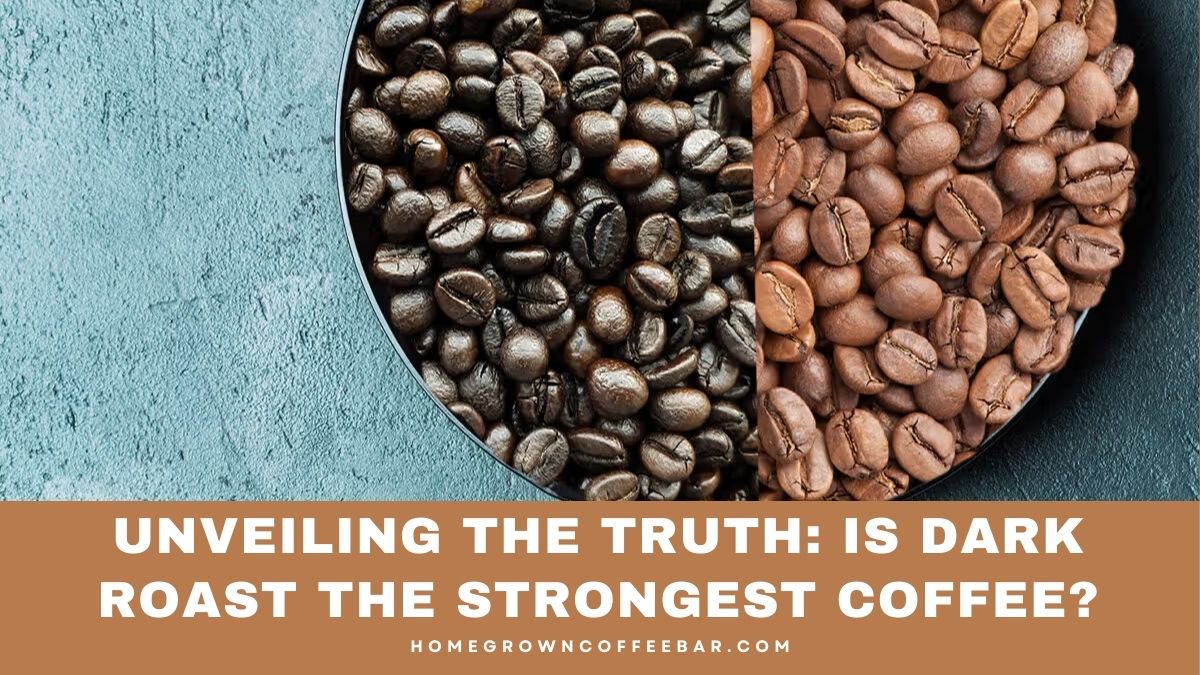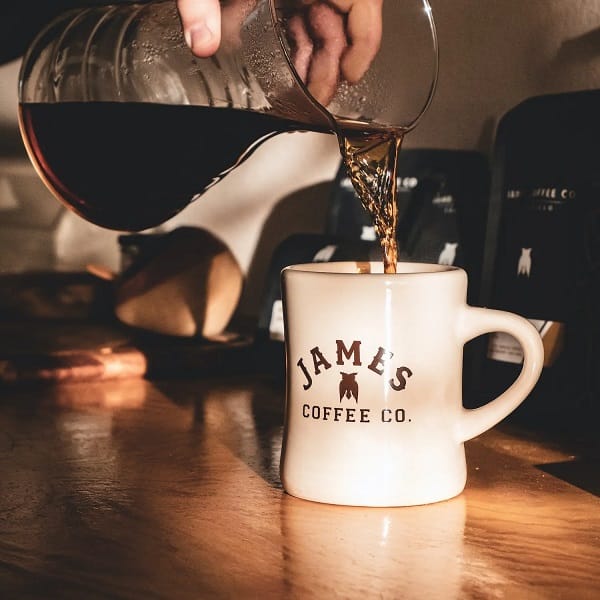Are you wondering, “Is dark roast the strongest coffee?” This age-old debate among coffee enthusiasts has sparked curiosity and interest in understanding the nuances of coffee roasts and their effects on caffeine content and flavor profiles. Let’s delve into the world of coffee roasting to uncover the truth behind whether dark roast truly reigns as the strongest coffee option available.
Debunking the Myth: Is Dark Roast Truly the Strongest Coffee?
Contrary to popular belief, dark roast coffee may not be the strongest. Many coffee enthusiasts swear by dark roast coffee’s intense flavor and aroma, associating it with a higher caffeine content. However, this is a common misconception.
The caffeine content in coffee is primarily determined by the bean’s species and the brewing method used, not the roast level. According to the National Coffee Association, a standard 8-ounce cup of coffee contains between 80-100mg of caffeine, regardless of the roast level. Whether you choose a light roast or a dark roast, you will still get a similar amount of caffeine per cup.
The misconception about dark roast coffee being stronger might arise from the bolder and more robust flavor profile typically associated with dark roasts. These roast levels produce more of the coffee’s natural oils, resulting in a rich, full-bodied taste. However, it’s important to note that flavor intensity does not necessarily equate to caffeine content.
Source: jamescoffeeco.com
It’s also worth mentioning that roasting coffee beans leads to a decrease in caffeine content. This means that lighter roasts, which are roasted for a shorter time, may have a slightly higher caffeine content than darker roasts.
Ultimately, choosing between dark roast and other roast levels is a personal preference. Some people enjoy a dark roast’s bold and smoky flavors, while others prefer a lighter roast’s brighter and more nuanced flavors. Whatever your preference may be, it’s important to know that the strength of the coffee is not solely determined by the roast level but by the bean species and brewing method.
Analyzing Caffeine Content in Dark Roast Coffee
Analyzing the caffeine content in dark roast coffee can help clarify the misconception of its strength compared to other roast levels. Contrary to popular belief, the roast level of coffee does not significantly affect the caffeine content. Instead, the species of the coffee beans and the brewing method play a more crucial role in determining the caffeine level.
Scientific research has found that dark roast coffee is not lower in caffeine than lighter roasts. Regardless of the roast level, a standard 8-ounce cup of coffee typically contains between 80-100mg of caffeine. Whether you choose a dark or light roast, you will receive a similar amount of caffeine per cup.
The misconception that dark roast coffee is stronger regarding caffeine might stem from its bolder flavor profile. Dark roasting brings out the natural oils in the coffee beans, resulting in a more robust and full-bodied taste. However, flavor intensity does not equate to higher caffeine content.
Interestingly, the process of roasting leads to a decrease in caffeine content. Lighter roasts, which are roasted for a shorter time, may have a slightly higher caffeine content than darker roasts. This is because prolonged roasting can result in the breakdown of caffeine molecules.
It is important to note that individual tolerance to caffeine can vary. Some individuals may feel more stimulated by dark roast coffee due to its intense flavor and aroma, but this is not directly related to the caffeine content.
Understanding Flavor Profiles and Strength in Different Roasts
Different roast levels of coffee produce distinct flavor profiles and varying levels of strength. Understanding these profiles can help you choose a roast that aligns with your taste preferences.
- Light Roast: Light roast coffee is known for its light brown color and mild flavor profile. It is often described as having a more acidic and fruity taste, with subtle nuances of the coffee beans’ origin. Light roasts retain more of the original characteristics of the coffee beans and showcase their unique flavors. Regarding strength, light roasts typically have a higher caffeine content due to the shorter roasting time.
- Medium Roast: Medium roast coffee balances the coffee beans’ flavors and the roasting process’s intensity. It has a medium-brown color and a balanced flavor profile featuring a pleasant combination of acidity, sweetness, and aroma. Medium roasts are often the most popular choice among coffee enthusiasts, offering a well-rounded and versatile taste. In terms of strength, medium roasts retain a moderate amount of caffeine.
- Dark Roast: Dark roast coffee is renowned for its bold, rich, and intense flavor. The beans are dark brown or even black, and the roasting process brings out smoky, chocolatey, and caramelized notes. Dark roasts have a lower acidity and tend to have a fuller body and heavier mouthfeel. Despite their bold taste, dark roasts have caffeine content similar to lighter roasts.
Strength in terms of flavor can be subjective and depends on individual preferences. Some coffee drinkers perceive darker roasts as stronger due to their more pronounced flavors, while others may find lighter roasts more stimulating. It’s important to experiment with different roast levels to find the one that suits your taste preferences and provides the desired level of strength.
The Impact of Roasting on Coffee’s Health Benefits
Roasting plays a significant role in shaping the flavor and aroma of coffee, but it also affects its health benefits. While the roasting process can lead to some loss of certain nutrients, it also creates compounds that offer various health-promoting properties.
One of coffee’s most well-known health benefits is its high antioxidant content. Antioxidants help protect the body against free radicals, and unstable molecules that can damage cells and contribute to chronic diseases like cancer and heart disease. Research has shown that the roasting process increases the antioxidant activity in coffee beans, meaning that darker roasts tend to have higher levels of antioxidants than lighter roasts.
In addition to antioxidants, coffee contains other bioactive compounds that are beneficial for health. For example, chlorogenic acid, which is abundant in coffee beans, has been linked to a lower risk of type 2 diabetes and heart disease. The roasting process can lead to the degradation of some chlorogenic acids, but it also generates new compounds that have health benefits.
Furthermore, research suggests that the compounds formed during roasting have anti-inflammatory and neuroprotective effects. These properties may help reduce the risk of certain neurodegenerative diseases, such as Alzheimer’s and Parkinson’s (Source).
Exploring Popular Dark Roast Coffee Varieties
When it comes to dark roast coffee, there are several popular varieties that coffee enthusiasts often seek out for their unique flavors and distinct characteristics. Here are some of the most well-known and beloved dark roast coffee varieties:
- Colombian Supremo: Colombian coffee is renowned for its rich and full-bodied flavor, and when roasted to a dark level, it produces a bold and intense cup of coffee. The Supremo variety, known for its large beans, offers a smooth and balanced flavor with hints of chocolate and nuts.
- Italian Roast: This roast is often associated with the traditional espresso culture in Italy. Its deep, dark color and intense, smoky flavor characterize it. Italian roast coffee is known for its thick and velvety texture, making it ideal for espresso-based drinks.
- French Roast: Considered one of the darkest roast levels, French roast coffee beans are roasted until they have a shiny black appearance. This roast creates a strong, bold coffee with a rich, caramel-like flavor and slightly charred taste. It is a favorite among those who enjoy a robust, full-bodied coffee cup.
- Sumatra: Grown in Indonesia’s lush, tropical forests, Sumatra coffee is known for its earthy and complex flavors. When roasted to a dark level, it develops a syrupy body and a unique combination of herbal, spicy, and chocolatey notes. Those who prefer a bold and adventurous taste experience often enjoy Sumatra dark roast coffee.
- Ethiopian Sidamo: This coffee variety hails from the birthplace of coffee itself. When roasted to a dark level, Ethiopian Sidamo beans exhibit a deep and rich flavor profile with dark chocolate, blueberry, and wine notes. The result is a cup of coffee that is both bold and vibrant.
Remember, the flavors and characteristics of each dark roast coffee variety can be influenced by factors such as the origin of the beans, the altitude at which they are grown, and the roasting techniques used. Exploring different dark roast coffee varieties allows you to discover your favorites and truly appreciate the diverse world of coffee. So go ahead, indulge in the richness of a dark roast, and experience the depths of flavor it offers.
Tips for Brewing and Enjoying Dark Roast Coffee
When brewing and enjoying dark roast coffee, a few tips can enhance your overall coffee experience. Here are some helpful suggestions for getting the most out of your dark roast brew:
- Use Freshly Roasted Beans: Dark roast coffee beans are best enjoyed when fresh. Look for beans with a roast date on the packaging and try to use them within two weeks of that date for optimal flavor.
- Grind Your Beans Right Before Brewing: To maximize the flavor and aroma of your dark roast coffee, grind the beans just before brewing. This ensures that the oils and flavors are released at their peak.
- Experiment with Different Brew Methods: Dark roast coffee can be brewed using various methods such as French press, pour-over, or espresso. Experiment with different techniques to find your preferred brewing method that brings out the unique qualities of the dark roast.
- Adjust the Brew Ratio: Dark roast coffee tends to have a bolder and richer flavor, so you might want to adjust the brew ratio to your preference. You can try using a slightly higher coffee-to-water ratio to intensify the flavors.
- Control Water Temperature: Water temperature plays a crucial role in extraction. For dark roast coffee, aim for a water temperature between 195 to 205°F (90 to 96°C) to extract the optimal flavors from the beans.
- Pay Attention to Brewing Time: Dark roast coffee often requires a slightly longer brewing time than lighter roasts. Be mindful of the brewing time to achieve the desired strength and flavor profile.
- Let the Coffee Rest: After brewing, allow the coffee to rest for a few minutes before serving. This helps the flavors to settle and intensify, resulting in a more balanced and enjoyable cup of coffee.
- Serve in Warm Mugs: To fully appreciate the richness of dark roast coffee, pre-warm your coffee mugs before serving. This helps to maintain the coffee’s temperature and enhances the overall tasting experience.
By following these tips, you can elevate your dark roast coffee brewing techniques and enjoy a cup that showcases the bold and robust flavors that dark roast is known for. So go ahead, explore the world of dark roast coffee, and savor every sip.


